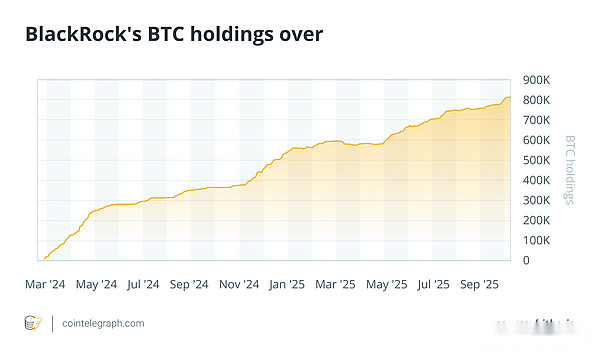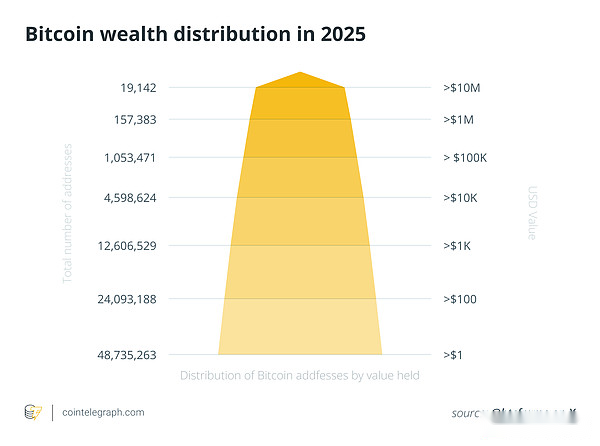
Author: Bradley Peak, Source: Cointelegraph, Compiler: Shaw Bitcoin Vision
Key takeaways
-
Since 2024, inflows and outflows from spot ETFs have been the main driver of Bitcoin’s rise and fall.
-
With exchange balances near multi-year lows, any large orders will need to go through a longer trading process to complete.
-
Large position holders will often split trades or use OTC platforms, thus mitigating the apparent “wallet transfer” shock.
-
Funding rates, open interest, USD, and yields often influence the market direction of the day more than any single wallet address.
Everyone “knows” whales trade Bitcoin, and they can still move the price.
Since the advent of spot exchange-traded funds (ETFs), Bitcoin’s movements have often been determined by ETF inflows and outflows.It also depends on the actual supply of Bitcoin available for trading on the exchange, rather than the wishes of a single wallet.For example, BlackRock’s iShares Bitcoin Trust ETF (IBIT) currently holds more than 800,000 Bitcoins on behalf of thousands of investors.The ETF’s liquidity rivals that of any single holder.
Factor in derivatives contracts and broader risk appetite/risk aversion sentiments and you can see the real picture.
This article cuts through the myths surrounding whale trading, explains the market mechanics that really matter, and provides a quick data list so you can read the market without chasing every “whale just sold” hot news.

What kind of investor is considered a “whale”?
In the cryptocurrency world, a “whale” refers to an on-chain entity that holds at least 1,000 Bitcoins.Many dashboards specifically track Bitcoin holders in the 1,000 to 5,000 Bitcoin range.
An entity refers to a group of addresses controlled by the same owner, rather than a single wallet.The analytics firm groups addresses using heuristics such as co-spending and change detection to ensure the same holder is not counted twice in different deposits.
This distinction is crucial because raw Rich List address numbers may overstate concentration.Large services such as exchanges, ETF custodians, and payment processors operate thousands of wallets, and tagging clusters helps distinguish these wallets from end investors.Research in academia and industry has long cautioned against drawing conclusions based on address data alone.
Methodologies vary.Some whale indicators include service entities such as exchanges, ETFs or custody pools, as well as companies.Other indicators exclude known exchange and miner clusters to focus on real investor whales.
Throughout this article, we use the entity-based convention (≥1,000 BTC) and clearly note inclusion or exclusion of service wallets to understand exactly what each metric means.
What is the current concentration level of Bitcoin?Who holds it?
Since the launch of the U.S. Spot ETF, a significant amount of visible Bitcoin supply has been moved into custodial pools.BlackRock’s IBIT alone holds about 800,000 Bitcoins, making it the largest known holder.However, these Bitcoins are not held in a single account but are instead held in trust on behalf of numerous investors.
The U.S. spot ETFs held by various issuers total approximately 1.66 million Bitcoins, accounting for approximately 6.4% of the total supply of 21 million Bitcoins.This execution model leads to the centralization of transactions, although underlying ownership remains widely distributed.
Businesses are another large group.Strategy recently disclosed holding approximately 640,000 Bitcoins.Miners, exchanges, and undisclosed long-term holders make up the remaining largest groups.
At the same time, the tradable liquidity of centralized exchanges continues to shrink.Tracking data from Glassnode shows that its circulating supply fell to approximately 2.83 million Bitcoins in early October 2025, a six-year low.With fewer tokens on exchanges, large orders are more likely to have an impact on the price.
Note that “top address” rich lists tend to exaggerate cryptocurrency concentration, as large service providers operate tens of thousands of wallets.Clustering at the entity level and labeling wallets of ETFs, exchanges, and companies can more clearly show the actual controllers of cryptocurrencies.

Can the whales turn the market around intraday?
Large aggressive orders can drastically affect price movements, especially if the order book is not deep enough.During periods of market volatility, when liquidity often dries up, large sell orders can penetrate the order book and create a huge impact.This is the basic market microstructure.
Because of this, many large position holders avoid “hitting the market.”They split orders or quietly execute large trades through over-the-counter (OTC) channels, reducing the impact of trading activity and information leakage.In fact, a significant portion of large-volume trading activity occurs outside of exchanges, which reduces the visible impact of individual wallets on public trading venues.
Whales don’t always “buy” in different cycles.Research combining trading and on-chain data shows that large holders tend to sell when markets are strong, especially when small investors buy.Their flows could dampen gains rather than lead them.
The 2025 chart fits the pattern: as prices broke above $120,000 on strong ETF inflows and widespread buying, some whales took profits.Intraday price movements tend to be influenced more by ETF flows and available liquidity than by the movements of any single whale wallet.
What are the factors that really drive the market up and down most of the time?
Since January 2024, spot ETF flows have become one of the most reliable signals of Bitcoin’s daily movements.Strong weekly inflows tend to coincide with new Bitcoin price highs, while weak or negative inflows tend to coincide with falling Bitcoin prices.Combined with the real-time fund flow dashboard, the fund flow of U.S. ETFs on each trading day can be tracked.
Liquidity on exchanges is also critical.As the balance of Bitcoins on centralized exchanges has dropped to approximately 2.83 million, a six-year low, the supply of tradable Bitcoins has significantly decreased.Lack of liquidity means that even routine buy and sell transactions can hit the order book, amplifying price movements across all participant types.
Contracts and leverage are often the main drivers of intraday price movements.The path of least resistance can change quickly when funds are flush or deep losses occur, and open interest (OI) rebuilds after a plunge.
Fund flows and open interest are continuously monitored to assess market congestion.Recently, about 97% of the supply has achieved profitability, and dividends to long-term holders have slowed slightly, making the market more sensitive to new capital flows and news.
Finally, macroeconomics still drives cryptocurrency volatility.Dollar movements, U.S. Treasury yields, and overall risk appetite generally move in tandem with Bitcoin’s intraday moves.On days with lighter data, ranges tend to narrow, and when macro factors heat up, cryptocurrency markets typically heat up along with them.
Quick data list
-
ETF fund flows: Track yesterday’s net inflow/net outflow and total trading volume.
-
Liquidity: Observe balance trends and order book depth on major trading venues.
-
Position: Review the post-liquidation funding rate heatmap and open interest reconstruction.
-
Macroeconomic dynamics: Monitors the U.S. dollar index, 10-year Treasury yield and stock market breadth.
Will giant whales still decide the trend of Bitcoin on the day?
Whales can influence price movements, but they rarely determine the final transaction price.When liquidity is low, a large order can cause prices to fluctuate more than normal.Most whales now split trades into smaller tranches or conduct trades through over-the-counter trading platforms, mitigating the impact of public trading on prices.
Since 2024, cash ETF flows and the huge trading volume of these funds have been the main factors influencing daily market direction.Looking at the previous day’s net fund flows and volume can provide a clearer picture of this trend.
With tradable supply on exchanges near multi-year lows, even small buyers or sellers — whether whales, market makers or retail traders — can influence prices more dramatically than usual.Large holders tend to sell when prices rise rather than “push” them higher, a pattern that tends to limit gains rather than fuel them.
Macro factors still largely influence market trends.Changes in the U.S. dollar and U.S. Treasury yields affect risk appetite and, in turn, Bitcoin’s movements.






